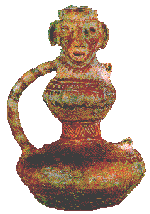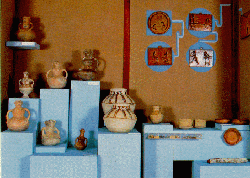 UAJIBOS
UAJIBOS UAJIBOS
UAJIBOS  |
"The Hiwi (Guajibo) are a relatively heterogeneous population, very disseminated. They inhabit the savannas of the west of Venezuela and Colombia. Today they occupy almost all the Comisarí to of Vichada (Colombia), in the zone that extends among the rivers Meta(north), Vichada (south), Orinoco (east) and Mnacacíace (west). A few groups to the north exist near the rivers Meta and Orinoco, in the Colombian Department of Boyacá and the intendiencias of Casanare and Arauca, and in the Venezuelan states Apure, Guárich (Cabruta) and Bolívar (The Urban one and Villacoa). Also in Venezuelan territory are various groups on the river banks of the Orinoco and a few villages in the Maniapare River(Federal Territory Amazonas). The majority of the Hiwi reside in Colombia and many of the ones that inhabit at present the banks of the Orinoco and the Manapiare (Venezuela) are individuals that emigrated recently from the Vichada region(Colombia)". |
"The first thing to be said specifically about the Hiwi is a story of the expedition of Federmann to the Plains, near the river Meta, in 1538. That expedition found groups of Indian nomads mentioned with names as diverse as Guaigua, Guahigua, Guashigua and Guayhigua".
"...Documents of the 16th century speak about the sharp destruction of the Indian cultures of the plains due to conquest: villages were destroyed, food was stolen and the Indians enslaved. Probably nomadic or seminomadic groups such as the Hiwi could have better evaded the contact with the Europeans.
 |
The nomadism of the Guajibos, with which the components of their diet were acquired, was the most important social characteristic in all the writings of the colonial period. "This innate independence resulted historically favorable to the Guajibo people, since not only did they not decrease, but they enlarged in number through time, giving them the name of Masters of Survival". |
"The primary social unit among the Hiwi is the nuclear family. The family complies with sexual functions, reproduction, breeding and socialization, and is the economical basis of all.
We use the expression "habitatonal matrilocal extended group" to refer to a residential group that is comprised of a man, his wife, his children, single daughters, one or several married daughters, the husbands and the children of these. Inside this habitational group the male activities comprise the building of houses, hunting and fishing and tributes or revenges when necessary. The female activities are limited generally to domestic activities, the incessant processes of planting and taking care of the main cultivations, and also of preparing the casabe.
Traditionally among the Hiwi, two levels of identification have existed to besides the family units; the village and the subregional group or tribe. The village represents the first level of identification of the group and is, at the same time, the largest local unit (among 15 to 150 individuals). Neither their territory, nor their members are fixed... among the Hiwi there isn't a political or social organization. However a concept exists of identification that relates to the regional dialect.
In terms of identification the native people of a specific area believe that all are descended from a mythological being, be it an animal, a specific plant. In some tribes the members tend to think that are descendants of certain species of animals: there is a link of heir among the species and the members of the band. In other tribes the members are identified, in some way, with a species. They believe that their ancestors were born at the same time as this other species; but not believe to be really their descendants, but only related somehow with them.
The birth of the first son is the main event in the cycle of development of the domestic group. It generally stirs up the attention and worries of the husband, as well as the rest of the family.
Before adolescence children have no kind of responsibility. Later they try to imitate, and therefore, learn the tasks of their elders.
There are no rites of passage of adolescence. The assigning of a name is not something sistematic and does not imply a rite, neither the creation of reciprocal relations.. They consider that a man has reached the ideal age for marriage at 16 or 17.
When they think that a boy is ready for marriage, his father or his fathers brother tells him that he should leave his childlike name and take another.
Females are welcomed to adulthood by using a rite. This rite usually occurs between the ages of 12 and 14.
At the beginning of the first menstruation, they isolate the girl during a period from three weeks to a month... their nearby female relatives attend her and they instruct her in sexual matters and in the conduct of wife, mother, and how to take care of the house."




©Todos los derechos reservados, se prohibe la
reproducción salvo permiso por escrito del autor.
©All rigths reserved, material duplication is prohibited
without written authorization by its author.